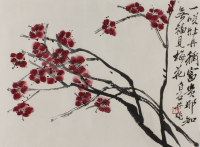Blossoming Apricot

Qi Baishi, Blossoming Apricot, 1945/1955, color woodblock print on paper, Gift of Donald and Mel Jenkins, © unknown, research required, 67.15.8
This work is not currently on view.
- Title
Blossoming Apricot
- Related Titles
original language: 梅花圖
- Artist
- Date
1945/1955
- Medium
color woodblock print on paper
- Dimensions (H x W x D)
image: 8 7/8 in x 12 3/16 in; sheet: 12 9/16 in x 17 in
- Inscriptions & Markings
inscription: 一咲牡丹稱富貴那知無福見梅花, printed, right margin Transliteration (Translation): Yixiao mudan cheng fugui nazhi wufujian meihua (Peony seems to be wealthy and honored, it is nothing better than plum blossom.) Language: Chinese
artist's seal: 木人, printed, right margin, bottom Transliteration: Muren Language: Chinese
signature: 白石題, printed, right margin, bottom Transliteration (Translation): Baishi bingti (Baishi painted and composed) Language: Chinese
- Collection Area
Asian Art; Graphic Arts
- Category
Prints
- Object Type
relief print
- Culture
Chinese
- Credit Line
Gift of Donald and Mel Jenkins
- Accession Number
67.15.8
- Copyright
© unknown, research required
- Terms
The plum blossom is called the Flower of Five Blessings because it symbolizes longevity, wealth, health, love of virtue, and a peaceful death. Here, Baishi compares the plum blossom favorably to the showier peony. He writes, "The peony is associated with wealth and nobility, but nothing is more auspicious than the plum blossom."
Baishi makes use here of his trademark combination of vivid red for the plum blossoms and black for the branches. His choice of the phrase muren (wood man) for his seal reflects his career as a carpenter and carver in his teenage years.









